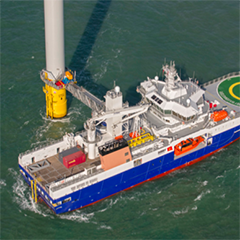W2W market maturing at last
It’s clear that the Walk to Work (W2W) concept is here to stay in both wind energy and the oil and gas industry. The major operators and turbine EPCs have all commissioned dedicated W2W vessels from various operators. The last 4 years has seen a number of new operators enter the market with different vessel designs and improved gangway designs. Now the question is who can deliver the required performance most effectively? PES turned to BMO Offshore for their thoughts.
The current situation is not unlike that of the crew transfer vessel (CTV) market of 10 years ago. It’s quite interesting to see the development of this new market in the light of the experiences of the CTV market.
CTVs were the genesis of the dedicated offshore wind vessels, and after an initial development phase, there was a substantial boom. At this time the market was flooded with new operators with exciting designs ranging from mono hull, catamaran, trimaran to Swath and surface effect Vessel.
Lessons learned on vessel performance
It was, however, quickly realized by many, that performance of the vessels was vastly different at different locations throughout Europe. Carbon Trust, in the UK, and others undertook substantial efforts to create transparency of performance and fuel efficiency.
The aim was to quantify the level of performance a charterer could reasonably expect for their vessels. This method uses measurements of vessel motion during present trials to determine key characteristics.
However, this scientific approach soon ran into a practical issue. Although general performance is nice to have, the difference is made at the edge of performance. This is the moment that the wind is strong (high production) and the sea is relatively rough. As it turns out, based on our 8 years of data collection and analysis, the key differentiator, given equal vessels, is the skipper and the trust placed in his judgement and capabilities by the technicians.
Skill, however, is a soft factor and doesn’t quite fit the technology oriented frame of mind of the offshore industry. This touches upon a common issue in this industry, as there is a strong tendency to solve a problem with ‘a bigger piece of steel’, rather than invest in the skills to wield the tool in the first place. It is our core belief that investing in human capital will gain much more results in this market than more hardware.
This brings us back to the current state of the W2W market. As we see it, the technology has been developed to a large extent. Now it is key to improve the effectiveness of deployment by the teams using it.



























